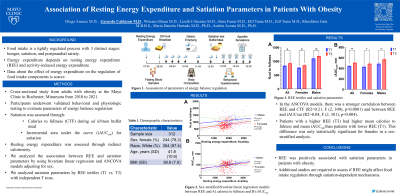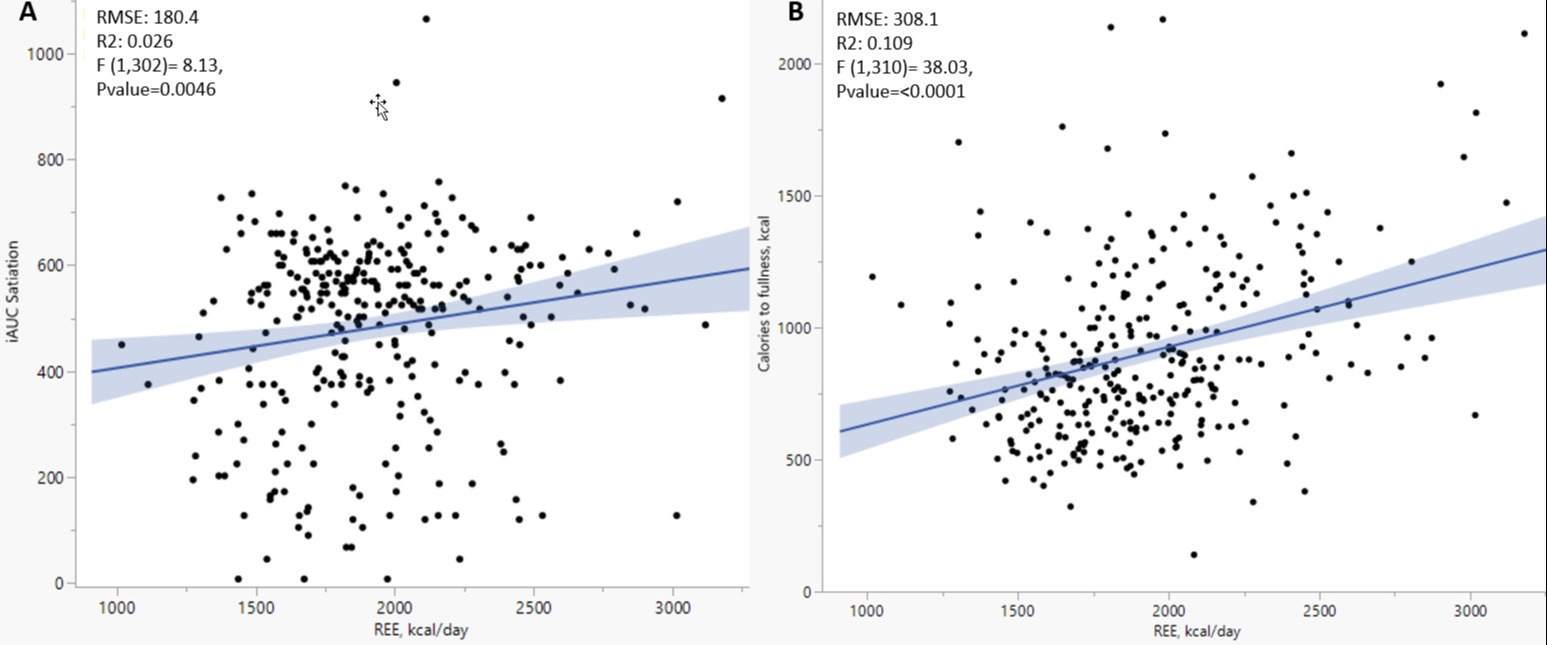Tuesday Poster Session
Category: Obesity
P4032 - Association of Resting Energy Expenditure and Satiation Parameters in Patients With Obesity
Tuesday, October 24, 2023
10:30 AM - 4:00 PM PT
Location: Exhibit Hall

Has Audio
- GC
Gerardo Calderon, MD
Mayo Clinic
Rochester, MN
Presenting Author(s)
Diego Anazco, MD1, Gerardo Calderon, MD1, Wissam Ghusn, MD1, Lizeth Cifuentes, MD2, Sima Fansa, MD1, Elif Tama, MD3, Khushboo Gala, MBBS1, Maria Daniela. Hurtado, MD, PhD3, Andres Acosta, MD, PhD1
1Mayo Clinic, Rochester, MN; 2UPMC, Pittsburgh, PA; 3Mayo Clinic, Jacksonville, FL
Introduction: Obesity results from a chronic energy imbalance. Food intake is a tightly regulated process with 3 distinct stages: hunger, satiation, and postprandial satiety. Energy expenditure depends on resting energy expenditure (REE) and activity-induced energy expenditure. Data about the effect of energy expenditure on the regulation of food intake components is scarce. We aim to assess if energy expenditure, quantified through REE, is associated with satiation, a key component of food intake regulation.
Methods: This is a cross-sectional study from adults with obesity participating in different clinical trials at the Mayo Clinic in Rochester, Minnesota from 2010 to 2021. All patients underwent a set of behavioral and physiological tests, including a) body composition analysis, b) indirect calorimetry, c) gastric emptying of solids after a standardized breakfast, and d) ad libitum buffet meal with Visual Analogue Scale (VAS) scores at -15, 0, 30, 60, 90, and 120 minutes from the meal start. REE was estimated with indirect calorimetry. We estimated the satiation incremental AUC (iAUCsat) by using the trapezoid method with the VAS scores at -15 and 0 minutes. Satiation was also assessed with calories to fulness (CTF) during the ad libitum buffet meal. We analyzed the association between REE and satiation parameters by using bivariate linear regression and ANCOVA models adjusting for sex. Continuous data is presented as mean (standard deviation).
Results: We included 312 participants [78.2% female, 97.4% White, age 41.8 (10.6), BMI 38.8 (7.0)] (Table 1). In the bivariate linear regression models, we found that REE had a significant positive correlation with CTF (R2= 0.11, F (1,310) = 38.03, p< 0.0001) and iAUCsat (R2= 0.03, F (1,302) = 8.13, p=0.005) (Figure 1). The assumption of homogeneity of regression of slopes to include sex in the ANCOVA models was met. In the ANCOVA models, there was a stronger correlation between REE and CTF (R2=0.21, F (2, 309), p< 0.0001) and between REE and iAUCsat (R2=0.04, F (2, 301), p=0.004).
Discussion: REE was positively associated with satiation parameters in patients with obesity. Additional studies are required to assess if REE might affect food intake regulation through satiation-dependent mechanisms.

Disclosures:
Diego Anazco, MD1, Gerardo Calderon, MD1, Wissam Ghusn, MD1, Lizeth Cifuentes, MD2, Sima Fansa, MD1, Elif Tama, MD3, Khushboo Gala, MBBS1, Maria Daniela. Hurtado, MD, PhD3, Andres Acosta, MD, PhD1. P4032 - Association of Resting Energy Expenditure and Satiation Parameters in Patients With Obesity, ACG 2023 Annual Scientific Meeting Abstracts. Vancouver, BC, Canada: American College of Gastroenterology.
1Mayo Clinic, Rochester, MN; 2UPMC, Pittsburgh, PA; 3Mayo Clinic, Jacksonville, FL
Introduction: Obesity results from a chronic energy imbalance. Food intake is a tightly regulated process with 3 distinct stages: hunger, satiation, and postprandial satiety. Energy expenditure depends on resting energy expenditure (REE) and activity-induced energy expenditure. Data about the effect of energy expenditure on the regulation of food intake components is scarce. We aim to assess if energy expenditure, quantified through REE, is associated with satiation, a key component of food intake regulation.
Methods: This is a cross-sectional study from adults with obesity participating in different clinical trials at the Mayo Clinic in Rochester, Minnesota from 2010 to 2021. All patients underwent a set of behavioral and physiological tests, including a) body composition analysis, b) indirect calorimetry, c) gastric emptying of solids after a standardized breakfast, and d) ad libitum buffet meal with Visual Analogue Scale (VAS) scores at -15, 0, 30, 60, 90, and 120 minutes from the meal start. REE was estimated with indirect calorimetry. We estimated the satiation incremental AUC (iAUCsat) by using the trapezoid method with the VAS scores at -15 and 0 minutes. Satiation was also assessed with calories to fulness (CTF) during the ad libitum buffet meal. We analyzed the association between REE and satiation parameters by using bivariate linear regression and ANCOVA models adjusting for sex. Continuous data is presented as mean (standard deviation).
Results: We included 312 participants [78.2% female, 97.4% White, age 41.8 (10.6), BMI 38.8 (7.0)] (Table 1). In the bivariate linear regression models, we found that REE had a significant positive correlation with CTF (R2= 0.11, F (1,310) = 38.03, p< 0.0001) and iAUCsat (R2= 0.03, F (1,302) = 8.13, p=0.005) (Figure 1). The assumption of homogeneity of regression of slopes to include sex in the ANCOVA models was met. In the ANCOVA models, there was a stronger correlation between REE and CTF (R2=0.21, F (2, 309), p< 0.0001) and between REE and iAUCsat (R2=0.04, F (2, 301), p=0.004).
Discussion: REE was positively associated with satiation parameters in patients with obesity. Additional studies are required to assess if REE might affect food intake regulation through satiation-dependent mechanisms.

Figure: Figure 1. Bivariate linear regression models between resting energy expenditure (REE) and A) Incremental area under the curve (iAUC) for Satiation, and B) Calories to fullness during an ad libitum buffet meal.
Disclosures:
Diego Anazco indicated no relevant financial relationships.
Gerardo Calderon indicated no relevant financial relationships.
Wissam Ghusn indicated no relevant financial relationships.
Lizeth Cifuentes indicated no relevant financial relationships.
Sima Fansa indicated no relevant financial relationships.
Elif Tama indicated no relevant financial relationships.
Khushboo Gala indicated no relevant financial relationships.
Maria Hurtado indicated no relevant financial relationships.
Andres Acosta: Amgen Pharmaceuticals – Consultant. General Mills – Consultant. Gila Therapeutics – Stock-privately held company. Phenomix Sciences – Stock-privately held company. Rhythm Pharmaceuticals – Consultant.
Diego Anazco, MD1, Gerardo Calderon, MD1, Wissam Ghusn, MD1, Lizeth Cifuentes, MD2, Sima Fansa, MD1, Elif Tama, MD3, Khushboo Gala, MBBS1, Maria Daniela. Hurtado, MD, PhD3, Andres Acosta, MD, PhD1. P4032 - Association of Resting Energy Expenditure and Satiation Parameters in Patients With Obesity, ACG 2023 Annual Scientific Meeting Abstracts. Vancouver, BC, Canada: American College of Gastroenterology.
